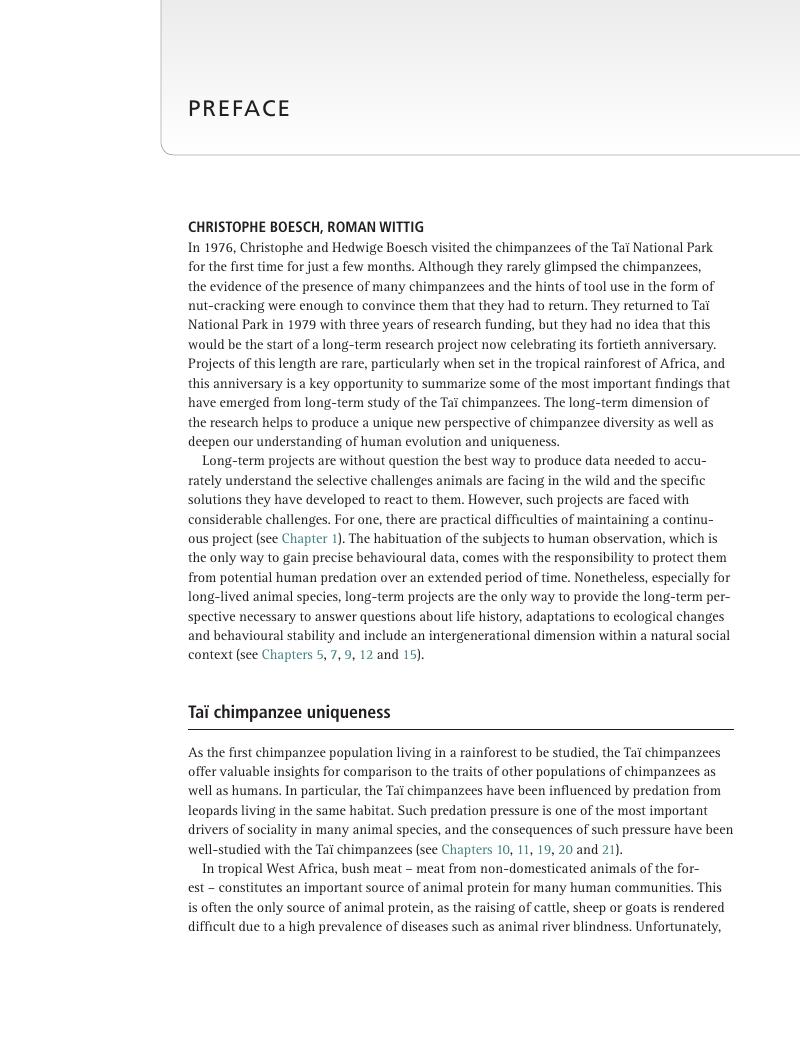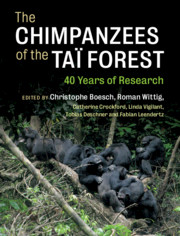Book contents
- The Chimpanzees of the Taï Forest
- The Chimpanzees of the Taï Forest
- Copyright page
- Dedication
- Contents
- Contributors
- Preface
- Acknowledgements
- 1 War and peace in the Taï chimpanzee forest: running a long-term chimpanzee research project
- 2 Developments in statistical methods applied over four decades of research in the Taï Chimpanzee Project
- 3 Observation protocol and long-term data collection in Taï
- 4 The Wild Chimpanzee Foundation (WCF) and the Taï Chimpanzee Project (TCP)
- 5 Insights from genetic analyses of the Taï chimpanzees
- 6 Endocrinological analyses at Taï
- 7 Chimpanzee behavioural diversity and the contribution of the Taï Chimpanzee Project
- 8 An energetic model of foraging optimization: wild chimpanzee hammer selection for nut-cracking
- 9 Demography and life history of five chimpanzee communities in Taï National Park
- 10 Adoption in the Taï chimpanzees: costs, benefits and strong social relationships
- 11 Spatial integration of unusually high numbers of immigrant females into the South Group: further support for the bisexually bonded model in Taï chimpanzees
- 12 Forty years striving to capture culture among the Taï chimpanzees
- 13 Cultural diversity of nut-cracking behaviour between two populations of wild chimpanzees (Pan troglodytes verus) in the Côte d’Ivoire
- 14 Ecological and social influences on rates of social play in immature wild chimpanzees (Pan troglodytes verus)
- 15 Long-term diet of the chimpanzees (Pan troglodytes verus) in Taï National Park: interannual variations in consumption
- 16 Why Taï mangabeys do not use tools to crack nuts like sympatric-living chimpanzees: a cognitive limitation on monkey feeding ecology
- 17 Providing research for conservation from long-term field sites
- 18 Rank changes in female chimpanzees in Taï National Park
- 19 Effects of large-scale knockouts on chimpanzee association networks
- 20 Why do the chimpanzees of the Taï Forest share meat? The value of bartering, begging and hunting
- 21 Group-specific social dynamics affect urinary oxytocin levels in Taï male chimpanzees
- 22 The chimpanzees of the Taï Forest as models for hominine microorganism ecology and evolution
- 23 Acute infectious diseases occurring in the Taï chimpanzee population: a review
- 24 Why does the chimpanzee vocal repertoire remain poorly understood and what can be done about it?
- 25 Evidence for sexual dimorphism in chimpanzee vocalizations: a comparison of male and female call production and acoustic parameters
- 26 Gestural usage and development in two chimpanzee groups of different subspecies (Pan troglodytes verus/P.t. schweinfurthii)
- 27 Spatial cognitive abilities in foraging chimpanzees
- 28 Temporal cognition in Taï chimpanzees
- Index
Preface
Published online by Cambridge University Press: 25 November 2019
- The Chimpanzees of the Taï Forest
- The Chimpanzees of the Taï Forest
- Copyright page
- Dedication
- Contents
- Contributors
- Preface
- Acknowledgements
- 1 War and peace in the Taï chimpanzee forest: running a long-term chimpanzee research project
- 2 Developments in statistical methods applied over four decades of research in the Taï Chimpanzee Project
- 3 Observation protocol and long-term data collection in Taï
- 4 The Wild Chimpanzee Foundation (WCF) and the Taï Chimpanzee Project (TCP)
- 5 Insights from genetic analyses of the Taï chimpanzees
- 6 Endocrinological analyses at Taï
- 7 Chimpanzee behavioural diversity and the contribution of the Taï Chimpanzee Project
- 8 An energetic model of foraging optimization: wild chimpanzee hammer selection for nut-cracking
- 9 Demography and life history of five chimpanzee communities in Taï National Park
- 10 Adoption in the Taï chimpanzees: costs, benefits and strong social relationships
- 11 Spatial integration of unusually high numbers of immigrant females into the South Group: further support for the bisexually bonded model in Taï chimpanzees
- 12 Forty years striving to capture culture among the Taï chimpanzees
- 13 Cultural diversity of nut-cracking behaviour between two populations of wild chimpanzees (Pan troglodytes verus) in the Côte d’Ivoire
- 14 Ecological and social influences on rates of social play in immature wild chimpanzees (Pan troglodytes verus)
- 15 Long-term diet of the chimpanzees (Pan troglodytes verus) in Taï National Park: interannual variations in consumption
- 16 Why Taï mangabeys do not use tools to crack nuts like sympatric-living chimpanzees: a cognitive limitation on monkey feeding ecology
- 17 Providing research for conservation from long-term field sites
- 18 Rank changes in female chimpanzees in Taï National Park
- 19 Effects of large-scale knockouts on chimpanzee association networks
- 20 Why do the chimpanzees of the Taï Forest share meat? The value of bartering, begging and hunting
- 21 Group-specific social dynamics affect urinary oxytocin levels in Taï male chimpanzees
- 22 The chimpanzees of the Taï Forest as models for hominine microorganism ecology and evolution
- 23 Acute infectious diseases occurring in the Taï chimpanzee population: a review
- 24 Why does the chimpanzee vocal repertoire remain poorly understood and what can be done about it?
- 25 Evidence for sexual dimorphism in chimpanzee vocalizations: a comparison of male and female call production and acoustic parameters
- 26 Gestural usage and development in two chimpanzee groups of different subspecies (Pan troglodytes verus/P.t. schweinfurthii)
- 27 Spatial cognitive abilities in foraging chimpanzees
- 28 Temporal cognition in Taï chimpanzees
- Index
Summary

- Type
- Chapter
- Information
- The Chimpanzees of the Taï Forest40 Years of Research, pp. xiii - xviPublisher: Cambridge University PressPrint publication year: 2019

